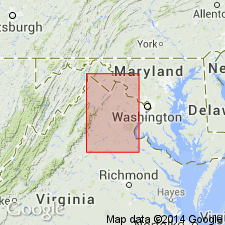
- Usage in publication:
-
- Midland Formation*
- Modifications:
-
- Named
- Dominant lithology:
-
- Sandstone
- Siltstone
- Limestone
- AAPG geologic province:
-
- Piedmont-Blue Ridge province
- Culpeper basin
Summary:
The Midland Formation of the Culpeper Group is named for fossil fish-bearing shale beds along Licking Run, north of the town of Midland, Fauquier Co., Va. These beds were first described by Baer and Martin (1949). The Midland consists of dark-red sandstone interbedded with siltstone, limestone, and microlaminated fossiliferous gray shale. It occupies a belt 1 km (0.6 mi) wide and is in disconformable or paraconformable contact with the underlying Mount Zion Church Basalt and the overlying Hickory Grove Basalt. Thickness ranges from 150 to 300 m (50 to 100 ft). Age is Hettangian based on sporomorphs (Cornet, 1977).
Source: GNU records (USGS DDS-6; Reston GNULEX).
For more information, please contact Nancy Stamm, Geologic Names Committee Secretary.
Asterisk (*) indicates published by U.S. Geological Survey authors.
"No current usage" (†) implies that a name has been abandoned or has fallen into disuse. Former usage and, if known, replacement name given in parentheses ( ).
Slash (/) indicates name conflicts with nomenclatural guidelines (CSN, 1933; ACSN, 1961, 1970; NACSN, 1983, 2005, 2021). May be explained within brackets ([ ]).

